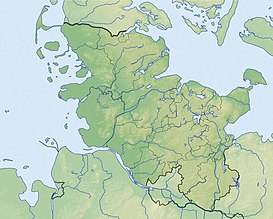Ehndorf transmitter
|
Ehndorf transmitter
|
||
|---|---|---|
| Basic data | ||
| Place: | Ehndorf | |
| Country: | Schleswig-Holstein | |
| Country: | Germany | |
| Altitude : | 13 m above sea level NN | |
| Coordinates: 54 ° 2 ′ 30.1 ″ N , 9 ° 50 ′ 52 ″ E | ||
| Use: | Broadcasting station | |
| Owner : | Media broadcast | |
| Mast data | ||
| Construction time : | 1967 | |
| Building material : | steel | |
| Operating time: | 1967-2015 | |
| Total height : | 65 m | |
| Data on the transmission system | ||
| Waveband : | AM station | |
| Radio : | MW broadcasting | |
| Position map | ||
|
|
||
The transmitter Ehndorf , also known as transmitter Neumünster , was a medium wave transmitter of Media Broadcast GmbH . The location is Ehndorf in Schleswig-Holstein .
construction
A directional antenna consisting of two 65-meter-high steel lattice masts with a triangular cross-section was used as the transmitting antenna. The directional radiation was necessary in order to avoid mutual interference with a medium-wave transmitter transmitting on the same frequency in Novi Sad (Serbia), over 1360 kilometers away .
history
The transmitter went into operation in November 1967, initially with 600 kW power on the frequency 1268 kHz. For this purpose, two 300 kW tube transmitters were used, which were interconnected to form 600 kW. When the Geneva Wave Plan came into force in 1978, the frequency was slightly changed to 1269 kHz.
The transmitter was renewed in 1986 for 6.5 million German marks , which today would correspond to around 5.9 million euros.
From 1967 to 1994 the German-language program of Deutschlandfunk was broadcast during the daytime for listeners in the former GDR and in the evenings foreign-language programs in Danish, Dutch, English, Norwegian and Swedish for listeners in northwestern Europe. On June 1, 1993, the foreign-language programs of Deutschlandfunk were taken over by Deutsche Welle , which enormously reduced the broadcasts from Ehndorf. On January 1, 1994, the foreign-language broadcasts ceased completely and since then the Deutschlandfunk program has been broadcast around the clock.
In 1995 the output was reduced from 600 kW to 300 kW. In 2005 Transradio installed a new 800 kW transmitter (TRAM 800), but the transmission power was never increased above 300 kW.
The Ehndorf transmitter was originally supposed to be switched off on December 31, 2014. This follows from a demand of the KEF , which called for the shutdown of all medium-wave and long-wave transmitters of the public broadcasters. In the future, DAB and the Internet will be used as an alternative means of receiving the sea weather reports broadcast from here . The shutdown date was postponed to the end of 2015 after protests.
On the evening of December 31, 2015, the transmitter, like all other medium-wave transmitters of Deutschlandfunk, was switched off shortly before midnight. Unlike on the other DLF MW frequencies, the pause signal was not sent beforehand, but the running program was abruptly aborted.
The transmitter systems were dismantled at the beginning of July 2018.
Others
Due to the good propagation conditions on the North Sea and the Baltic Sea , the Ehndorf transmitter was also used to broadcast sea weather reports . For this purpose, sea weather reports were broadcast daily at 1:05 a.m., 6:40 a.m., 11:05 a.m., and during the summer also at 9:05 p.m. instead of the Deutschlandfunk.
Individual evidence
- ↑ dradio.de: 300 kW transmitter with boiling-cooled transmitter tubes
- ↑ Installed power, see also GB 2005 from Transradio
- ↑ Deutschlandradio: Future of the sea weather report secured. July 2, 2013, accessed October 25, 2014 .
- ↑ Sea weather report in the DLF


